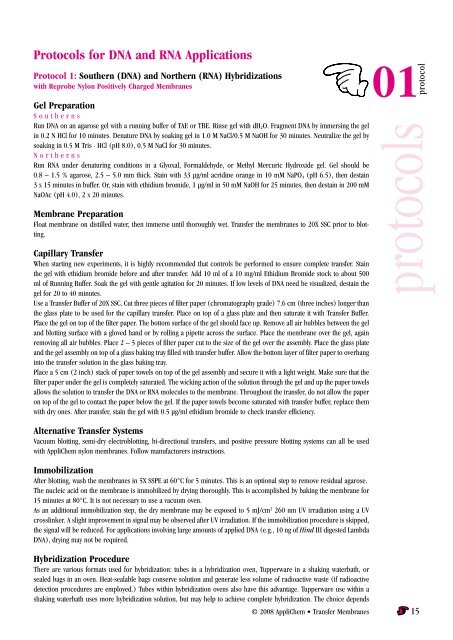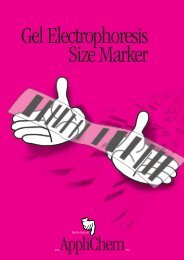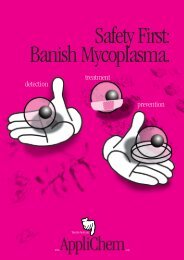Transfer Membranes
Transfer Membranes
Transfer Membranes
You also want an ePaper? Increase the reach of your titles
YUMPU automatically turns print PDFs into web optimized ePapers that Google loves.
Protocols for DNA and RNA Applications<br />
Protocol 1: Southern (DNA) and Northern (RNA) Hybridizations<br />
with Reprobe Nylon Positively Charged <strong>Membranes</strong><br />
Gel Preparation<br />
S o u t h e r n s<br />
Run DNA on an agarose gel with a running buffer of TAE or TBE. Rinse gel with dH 2O. Fragment DNA by immersing the gel<br />
in 0.2 N HCl for 10 minutes. Denature DNA by soaking gel in 1.0 M NaCl/0.5 M NaOH for 30 minutes. Neutralize the gel by<br />
soaking in 0.5 M Tris · HCl (pH 8.0), 0.5 M NaCl for 30 minutes.<br />
N o r t h e r n s<br />
Run RNA under denaturing conditions in a Glyoxal, Formaldehyde, or Methyl Mercuric Hydroxide gel. Gel should be<br />
0.8 – 1.5 % agarose, 2.5 – 5.0 mm thick. Stain with 33 µg/ml acridine orange in 10 mM NaPO 4 (pH 6.5), then destain<br />
3 x 15 minutes in buffer. Or, stain with ethidium bromide, 1 µg/ml in 50 mM NaOH for 25 minutes, then destain in 200 mM<br />
NaOAc (pH 4.0), 2 x 20 minutes.<br />
Membrane Preparation<br />
Float membrane on distilled water, then immerse until thoroughly wet. <strong>Transfer</strong> the membranes to 20X SSC prior to blotting.<br />
Capillary <strong>Transfer</strong><br />
When starting new experiments, it is highly recommended that controls be performed to ensure complete transfer. Stain<br />
the gel with ethidium bromide before and after transfer. Add 10 ml of a 10 mg/ml Ethidium Bromide stock to about 500<br />
ml of Running Buffer. Soak the gel with gentle agitation for 20 minutes. If low levels of DNA need be visualized, destain the<br />
gel for 20 to 40 minutes.<br />
Use a <strong>Transfer</strong> Buffer of 20X SSC. Cut three pieces of filter paper (chromatography grade) 7.6 cm (three inches) longer than<br />
the glass plate to be used for the capillary transfer. Place on top of a glass plate and then saturate it with <strong>Transfer</strong> Buffer.<br />
Place the gel on top of the filter paper. The bottom surface of the gel should face up. Remove all air bubbles between the gel<br />
and blotting surface with a gloved hand or by rolling a pipette across the surface. Place the membrane over the gel, again<br />
removing all air bubbles. Place 2 – 5 pieces of filter paper cut to the size of the gel over the assembly. Place the glass plate<br />
and the gel assembly on top of a glass baking tray filled with transfer buffer. Allow the bottom layer of filter paper to overhang<br />
into the transfer solution in the glass baking tray.<br />
Place a 5 cm (2 inch) stack of paper towels on top of the gel assembly and secure it with a light weight. Make sure that the<br />
filter paper under the gel is completely saturated. The wicking action of the solution through the gel and up the paper towels<br />
allows the solution to transfer the DNA or RNA molecules to the membrane. Throughout the transfer, do not allow the paper<br />
on top of the gel to contact the paper below the gel. If the paper towels become saturated with transfer buffer, replace them<br />
with dry ones. After transfer, stain the gel with 0.5 µg/ml ethidium bromide to check transfer efficiency.<br />
01<br />
protocol<br />
protocols<br />
Alternative <strong>Transfer</strong> Systems<br />
Vacuum blotting, semi-dry electroblotting, bi-directional transfers, and positive pressure blotting systems can all be used<br />
with AppliChem nylon membranes. Follow manufacturers instructions.<br />
Immobilization<br />
After blotting, wash the membranes in 5X SSPE at 60°C for 5 minutes. This is an optional step to remove residual agarose.<br />
The nucleic acid on the membrane is immobilized by drying thoroughly. This is accomplished by baking the membrane for<br />
15 minutes at 80°C. It is not necessary to use a vacuum oven.<br />
As an additional immobilization step, the dry membrane may be exposed to 5 mJ/cm 2 260 nm UV irradiation using a UV<br />
crosslinker. A slight improvement in signal may be observed after UV irradiation. If the immobilization procedure is skipped,<br />
the signal will be reduced. For applications involving large amounts of applied DNA (e.g., 10 ng of Hind III digested Lambda<br />
DNA), drying may not be required.<br />
Hybridization Procedure<br />
There are various formats used for hybridization: tubes in a hybridization oven, Tupperware in a shaking waterbath, or<br />
sealed bags in an oven. Heat-sealable bags conserve solution and generate less volume of radioactive waste (if radioactive<br />
detection procedures are employed.) Tubes within hybridization ovens also have this advantage. Tupperware use within a<br />
shaking waterbath uses more hybridization solution, but may help to achieve complete hybridization. The choice depends<br />
© 2008 AppliChem • <strong>Transfer</strong> <strong>Membranes</strong> 15





